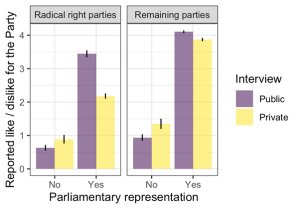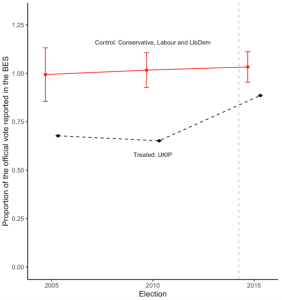Several countries around the world have recently witnessed very public displays of radical right behaviour. For example, during a protest in Chemnitz, Germany, in the summer of 2018, some demonstrators were seen giving a Nazi salute. Similarly, a year earlier during a protest in Charlottesville, VA, Charlottesville, VA, United States some demonstrators displayed confederate flags and swastikas. What explains this increased willingness to openly express radical right views?
Explicit support for the radical right: A reflection of changing perceptions of the cost of support
In a recent paper, I argue that these trends do not necessarily mean that individuals in these societies are becoming more extremist. They may also reflect a weakening of social norms against the expression of radical right views. If the social costs of engaging in radical right behaviour decrease, individuals who already had radical right views in private may feel more comfortable publicly expressing those views.
To test this argument, I focus on how the success of radical right politicians and candidates can normalise radical right views. Traditionally on the fringes, radical right politicians and parties have gained a central role in shaping policies in several countries. A central feature of this party family is its open disregard for established social norms, like those relating to inclusion, minority rights, and, in some cases, gender equality.
Drawing on the multidisciplinary social norms literature, I hypothesise that radical right individuals have an incentive to engage in preference falsification. Given that the rhetoric and policy stances of radical right parties openly challenge established social norms, showing support for these positions may lead to social repercussions. Fear of judgement or criticism may lead these supporters to refrain from openly expressing their beliefs in public.
But if radical right politicians become successful, radical right voters may realise that there is a critical mass of like-minded others in their society. Moreover, as radical right politicians enter representative institutions, voters may perceive their views as more legitimate than before. Consequently, they may feel more comfortable expressing in public the views that they already held in private.
This argument, however, is hard to test empirically. One needs to distinguish between voters who are radical right, but who falsify their preferences; and voters who simply are not radical right. Ideally, one would like to compare what individuals think in private to what they do in public; and check if the gap between the two becomes smaller when radical right parties are in parliament.
Voting for radical right parties is typically less openly admitted than support for other parties
In the paper, I devise three different strategies to compare the preferences that individuals express in private and in public. The general logic is that the more private a given behaviour is, the more likely someone is to act according to their private preferences. Conversely, the more public the behaviour, the more likely one is to act in accordance with social norms—even if this means deviating from what they think in private. Comparing the two therefore provides a measure of the strength of social norms for or against a particular behaviour. The stronger the social norm, the more likely individuals are to deviate publicly from what they think privately.
Following this logic, the first study proposes an observational measure of how publicly acceptable it is to support a given party. This measure is called the reported vote. It captures the proportion of the official vote for a given party that is declared in post-electoral surveys. The logic is that, because voting is private, social pressure is unlikely to influence it as much. As such, the vote share for a given party can be taken as a measure of how many individuals support that party under conditions of weak social pressure. In turn, the vote share for the same party as declared in surveys can be taken as a measure of how many individuals are willing to tell someone else (the survey interviewer) that they support it under conditions of pressure to give the socially desirable answer. Finally, the proportion of the two can be taken as a measure of how much individuals perceive it to be socially acceptable to support a given party.
I start by showing that the radical right is the only party family for which the official vote is under-reported in surveys. On average, only four out of five individuals who vote for a radical right party admit to doing so in a survey interview. This is not the case for parties of other ideologies.
Willingness to admit having voted for radical right parties increases they are in parliament
Then, I assess whether the parliamentary representation of the radical right makes its supporters right feel more comfortable acting on that support. If my argument is correct, we should observe that, when the radical right is in parliament, the share of the official vote for the radical right that is declared in surveys increases. This would suggest that, holding constant the number of people who support these parties, there are more individuals who feel comfortable admitting that support.
To test this expectation, I run a regression discontinuity design that takes advantage of the exogenous variation induced by legally fixed thresholds for parliamentary representation. A graphical representation of these analyses is shown in Figure 1 below. The x-axis represents how many percentage points away from the electoral threshold (above or below) each radical right party was. The y-axis represents the proportion of the official vote for that party that was declared in post electoral surveys.
Figure 1: Under-reporting of voting for radical right parties as a function of their distance from electoral thresholds to parliamentary representation.

The figure shows that there is a jump around the electoral threshold (dashed vertical line in the plot). This means that when radical right parties narrowly enter parliament, they are less under-reported in surveys than when they narrowly fail to enter parliament. This suggests that the parliamentary representation of the radical right makes individuals feel more comfortable expressing support for them. The analyses suggest that, for every ten people who voted for a radical right party, four to five more (depending on model specification) were willing to tell the interviewer that they did so when the party narrowly entered parliament than when it narrowly failed to do so.
The shortcoming of these analyses is that while the argument of the paper is at the individual level, the unit of analysis here is the party. To test whether the results hold at the individual level, Study 2 finds a way to approximate the analyses at that level.
Specifically, I look at some post-electoral surveys included in the CSES that use different interview modes for different respondents. Some were interviewed in ways that kept their answers private (like mail back and online modes), while others had to convey their answer to an interviewer (like face-to-face and telephone interviews).
This difference in interview modes generates variation in the level of pressure not to report radical right support. I assume that respondents interviewed in a more anonymous mode are more likely to reveal their private preferences. Then, I regress a variable asking respondents how much they like each party on each respondent’s interview mode (private or public), whether the party is radical right or not, whether the party is in parliament or not, and the two-way and three-way interactions between these variables.
These analyses, shown in Figure 2, suggest that individuals report liking radical right parties less than other parties, liking parties that are in parliament more, and liking parties more when the interview mode is private. But the difference between how much individuals report liking a party in private and public interview modes is reduced when the party makes it into parliament, and this reduction is greater in the case of radical right parties. This provides further empirical support for the normalisation effect of parliamentary entry.
Figure 2: How much individuals report to like radical right parties and the remaining ones, depending on interview mode and parliamentary presence.

UKIP as a case study to test dynamic changes normalisation of the radical right before and after it entered Parliament
These two complementary studies still leave one element of the argument untested. The argument is dynamic: it contends that the same party is stigmatised before it enters parliament but will be normalised once it enters parliament. Since both the party-level analyses and the individual-level analyses are rather static, they cannot test for this element of the argument.
To overcome this shortcoming, in Study 3 I examine the case of a radical right party that ran for several elections before entering parliament: the UK Independence Party. I use the same dependent variable as in the aggregate analyses of Study 1—reported vote, which captures the proportion of the official vote for the party that is reported in post-electoral surveys. Then, I run difference-in-differences models that compare the evolution of this variable for UKIP with that of the country’s mainstream parties.
The results, shown in Figure 3, again suggest that the vote share for UKIP was significantly less underreported after it entered parliament in 2015. For every ten individuals who voted for the party, two more were willing to tell the interviewer that they had done so after the party entered parliament.
Figure 3: Under-report of voting for UKIP, before and after UKIP entered parliament in 2015.

These analyses suggest that, while democracies tend to generate norms against behaviour that is deemed to be inconsistent with core democratic values, many individuals still hold counter-normative preferences in private—even if they do not disclose them in public. Since many who follow these norms engage in preference falsification, all it takes is an information shock that updates perceptions of norm strength to make individuals more comfortable acting on views that they already held in private. And an important implication of the argument is that this behavioural change can be very rapid because it does not require an actual change in individuals’ preferences—which we know is a more long-term process.
More broadly, the paper has implications for how we think about the translation of preferences into behaviour. It suggests that individuals can change their behaviour even when their preferences do not change. As I argue in more detail in my book project, individuals survey their social environment looking for cues about what is socially acceptable. If the cost of expressing these preferences is sufficiently high, they may develop a given preference but not actually act on it. Moreover, differences in behaviour can be brought about simply by a change in those costs, even if the sincere preferences of individuals do not actually change.
Note: This article reflects the views of the author and not the position of the DPIR or the University of Oxford.







